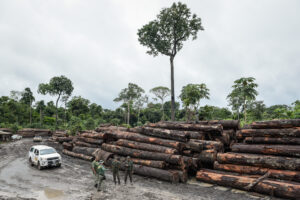The Global Race for Lithium Arrives in Rural Brazil
International mining companies arrive in Jequitinhonha Valley, promising development and provoking concerns about local compensation and water scarcity. Chapada do Lagoão, an environmentally protected area just outside of Araçuaí. Local communities repealed Sigma’s efforts to research lithium deposits here. Photo: Sam Klein-Markman / NACLA.
Chapada do Lagoão, an environmentally protected area just outside of Araçuaí. Local communities repealed Sigma’s efforts to research lithium deposits here. Photo: Sam Klein-Markman / NACLA.
In Araçuaí, a small city in southeastern Brazil an eight-hour drive from the nearest international airport, restauranteur Maria Aparecida Alves de Aguilar never imagined she would be printing English menus. Business has been unrecognizably active in recent months at Churrascaria e Restaurante 367. Work crews “call in lunches twenty at a time” and arrive in the evening for after-work beers.
Araçuaí is a small city in Jequitinhonha Valley, one of Brazil’s most impoverished regions. With 35,000 residents, it is one of the larger cities in a rural region that holds close to 750,000 people. Water is scarce, but over half of the valley’s residents are involved in some form of agriculture, many in subsistence farming. Jequitinhonha Valley has a long history of hunger, earning it the unfortunate nickname of “the Valley of Misery.”
Recently, however, the region has received a new name in political speeches and corporate communiques around the world: “Lithium Valley.”
The global energy transition is set to require a staggering increase in the lithium supply. An essential element in EV batteries, demand could increase as much as 42 times over two decades according to International Energy Agency projections. Jequitinhonha Valley sits on 85 percent of Brazil’s known lithium deposits, which has sparked a race to invest and develop. In May, Minas Gerais governor Romeu Zema and Brazilian federal officials traveled to Nasdaq in New York to launch the “Lithium Valley” project, looking for international investors for the lithium mining companies operating in the region.
In promoting this investment, officials are making the case that lithium mining will remake the long-neglected region into a “valley of opportunity.” Central to that campaign is Sigma Lithium, which began production in April, the first of the new mining companies in the region to do so. Sigma promises to produce a “green” lithium using renewable energy and 90 percent recycled water, to hire local, and to voluntarily invest more than the country requires in local municipalities and environmental projects.
Minas Gerais is also pursuing a policy of privatization and seeking international investment in lithium production.
Sigma expects its Grota do Cirilo mining site to be in production for 13 years, generating over $5 billion for the company and over $200 million in payments to local municipalities. This year, the company expects to pay around $10.7 million to Araçuaí and its neighboring town Itinga, just under a tenth of the two municipalities’ combined GDP according to data from Brazil’s 2022 census. Sigma has also instituted programs to construct wells for rural communities, create lines of microcredit for local women entrepreneurs, and pay for the preservation of local forest land.
Even so, as the region appears to be undergoing a transformative lithium boom, there is growing concern about the costs for rural communities that are most vulnerable to the environmental impacts of mining, and about whether local governments can translate the presence of international mining businesses into lasting gains for the region’s residents. The Movement for People Affected by Dams (MAB) has been campaigning against the advance of lithium mining, citing inevitable environmental degradation, water-intensive practices, and the opposition of federally protected quilombo communities—settlements generally founded by escaped slaves.
As critical metals become a key tool in global strategic and economic negotiations, Brazil is hoping to raise its profile as a major producer of lithium. According to Elaine Santos, who researches critical minerals at the University of Sao Paulo, the Lula administration’s policy toward lithium has been “largely one of continuity with the previous [Bolsonaro] administration, of liberalizing exports.” In 2022, former president Bolsonaro’s administration repealed a decades-old policy that restricted lithium exports. This year, Lula’s Ministry of Mines has partnered with the state government of Minas Gerais in promoting “Lithium Valley” to international investors.
Minas Gerais is also pursuing a policy of privatization and seeking international investment in lithium production. Last year, governor Romeu Zema sold the state’s 33 percent share in CBL, a lithium mining company operating in the state for decades. And this year, a bill is moving through the state assembly that would create a regional “Lithium Hub” that would permit the executive branch to create a special tax regime for lithium mining companies in the area.
Today in Araçuaí, new construction is the norm across the city. Maria says the change—visible from the patio of her restaurant—is striking. The neighboring hotel, which is “always full,” recently constructed a new building, doubling its capacity. A carwash and repair shop is being set up in the abandoned lot next door, and the gas station is now open 24 hours. “We are seeing our population investing, looking to improve,” she says. “This is good.”
In mid-June, the Minas Gerais Mayors’ Association (FMP) held its first public “Lithium Seminar,” bringing together national and state officials, business leaders, and local community organizers. Araçuaí mayor Tadeu Barbossa, from the Social Democratic Party, says he believes the city “has not experienced a moment as favorable as this.” Barbossa says that for lithium mining companies today, “there is now a market obligation, not a legal obligation, to arrive in a way that attends to social necessities, or to environmental issues.”
State deputy Jean Freire, from Lula’s Workers’ Party, echoed many of his colleagues on stage in recognizing an opportunity, but expressed concern about trusting businesses to mitigate impacts on vulnerable communities and ensure the region is adequately compensated. Freire says that the valley has a long history of extractive industries, from diamond mining to eucalyptus plantations and recent dam construction, and that each declared “now progress is coming.”
“And we have the history of mining as a guide,” he says, pointing to trends that connect mining to increased violence, skyrocketing rents for local residents and students, and environmental damage. Still, he notes, “We have to keep in mind that this is the least developed region in Minas Gerais, and one of the least developed in Brazil. “We have an immense wealth, economically speaking, under our feet. What can we do to keep this wealth for our population?”
Part of the answer, for Freire and many other state and national officials on stage, is a policy aimed at developing lithium processing capacity in the region, and eventually, even manufacturing batteries in the area.
However, concrete steps toward this type of strategy are unclear. In the state legislature, Freire’s “Lithium Hub” bill was stripped of language that would require lithium processing to occur in Jequitinhonha Valley. Nationally, Elaine Santos says, this type of strategy would be possible but would take years. Santos believes that the current lack of regulations for lithium exports will make it more difficult to create a competitive lithium processing and battery manufacturing chain in Brazil, and easier to end up exporting raw materials.
In some cases, local communities are directly competing with mining businesses for water and losing access to stable water supplies.
Local conflict over lithium primarily involves access to water, a resource that is scarce in the Jequitinhonha Valley. The activist group MAB, which has been organizing in the region since 1990, contends that “the struggle for access to water is the most important agenda in this semiarid region.” Though Sigma uses a state-of-the-art water recycling system, MAB points out that it still has a permit to use 3.8 million liters of water per day; in their calculations, enough to serve 34,000 families.
In some cases, local communities are directly competing with mining businesses for water and losing access to stable water supplies. On June 15, when the water truck arrived in Cinta Vermelha, an Indigenous village outside of Araçuaí, the driver told resident Cleonice Pankararu that the company would be making only one delivery the following week. The 10 families that make up Cinta Vermelha, like many communities in the area, rely on water deliveries during the dry season and receive a stipend from the federal Indigenous health agency to pay the local water company. But in recent months, Cleonice Pankararu (Pankararu is the name of her tribe) was told by representatives of the company that deliveries would be more infrequent and that in July, prices would rise beyond what her community can pay because Sigma can pay more. According to Cleonice, representatives of the water delivery company “explicitly” told her “that they would not renew their contract with us, that they were going to work with [Sigma] and that they could no longer serve our community.”
In recent months, she says, residents have had to cut back on baths and washing their clothes. Representatives from the Cinta Vermelha have been making trips to the state capital of Belo Horizonte hoping to obtain federal funds to buy a water truck for the community.
In May, MAB allied with state deputy Beatriz Cerqueira and local communities in a successful effort to repeal a Sigma permit to research lithium deposits in the Chapada do Lagoão, an Environmentally Protected Area (APA) outside of Araçuaí. MAB and Cerqueira submitted a complaint to the public prosecutor, alleging that the permit violated the rights of federally recognized quilombo communities, who did not receive “prior, free, informed and good faith consultation” as required by International Labor Organization Convention 169, which Brazil signed in 2002. MAB says the area is considered the “water tank of Araçuaí” and 300 families rely on the springs in the area for drinking water and subsistence farming.
Antonio Gomes represents farmers and laborers in the communities surrounding the city as the Political Director of the Union of Rural Workers of Araçuaí and lives within the protected area, where he grows pineapple and pequi fruit, a local staple. Gomes’s union voted in favor of the research permit, only to advocate to annul the permit months later.
At first, many union members thought, “We’ll let them research the area, but when they come back to ask to mine, we won’t authorize it,” says Gomes. Later, however, Gomes and community members considered the politics of the region. “If they research and find what they want, my god, it’ll be immediately liberated.” He says that MAB has been very involved in organizing and educating area residents. “Our population does not have much formal education,” says Gomes, “people don’t know where to find information on this.”
Even those who share these concerns find the unprecedented flow of resources difficult to turn down.
Gomes says he does not want the APA to undergo the disruption he has seen in Poço Dantas and Barreiros, small communities near the operational Sigma mine. According to both Gomes and MAB, residents complain of dust, noise that lasts long after midnight, and cracks emerging in their homes from explosions.
Even those who share these concerns find the unprecedented flow of resources difficult to turn down. As Program Coordinator for Araçuaí’s branch of the Popular Center for Culture and Development (CPCD), Marton Martins says the organization’s vote in favor of Sigma’s research permit was a vote for sorely needed information about the region. The CPCD has been involved in the APA area for years, developing permaculture sites, water capture systems, and youth education programs. “The Chapada is very large, and little understood. We know that it is a water source for the municipality. But there are no detailed technical studies of how it functions.” Martins says that a study locating the springs, detailing biome health and sanitation, and developing a management plan, which Sigma has proposed to fund, has long been “fundamental” to the CPCD’s aims to ensure water for the families in the area. The APA’s Council does not have the resources to take this on without outside help.
“The CPCD thinks of mining like the arrival of any other industry,” Martins explains. “How do they arrive, what compensation do they leave for the region?” Later he says, “A management plan [for the APA] would be an extremely important compensation.”
The CPCD said in a statement defending its vote in favor of Sigma’s research permit that in Jequitinhonha Valley “mining has occurred, is occurring, and will continue to occur.” They, like many others in the region, are left to navigate how their community might benefit and the limits that they are willing and able to impose.
Your support matters…Independent journalism is under threat and overshadowed by heavily funded mainstream media.
You can help level the playing field. Become a member.
Your tax-deductible contribution keeps us digging beneath the headlines to give you thought-provoking, investigative reporting and analysis that unearths what's really happening- without compromise.
Give today to support our courageous, independent journalists.






You need to be a supporter to comment.
There are currently no responses to this article.
Be the first to respond.